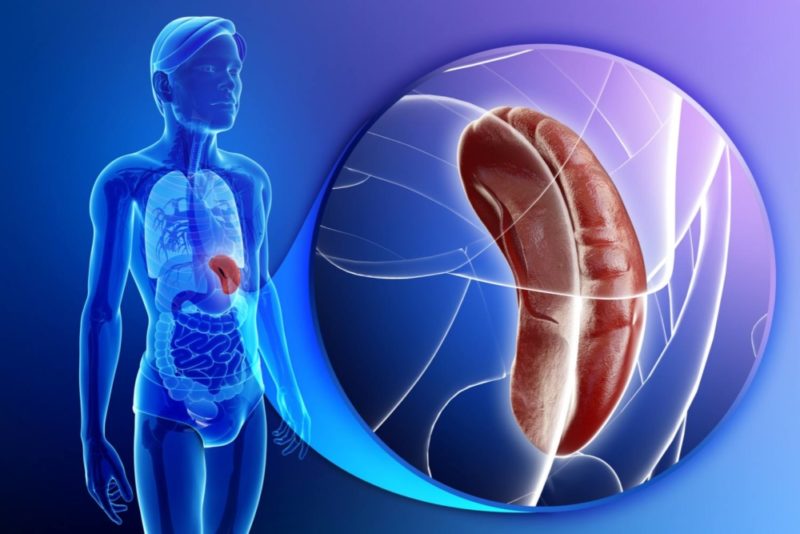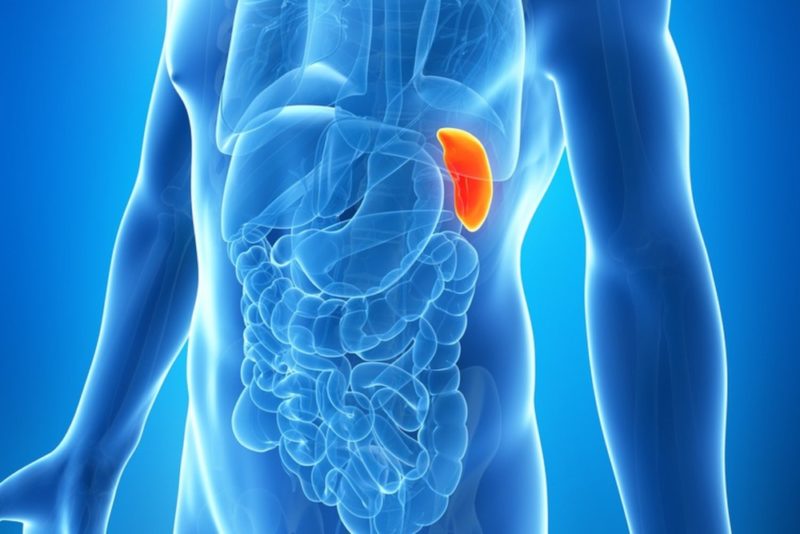The spleen is an unpaired abdominal organ and is not accessible for palpation. It is small in size. Length is about 120 mm, width is 80 mm, weight is about 150 g. But sometimes its hypertrophy occurs, which accompanies a number of diseases, exerting a negative effect on the whole body. This phenomenon is called splenomegaly.
Material Content:
What is splenomegaly
Splenomegaly - what is it and how does the process proceed? The deviation of the spleen parameters in the direction of increase is of a secondary nature, develops in response to the pathology in the body acting as the root cause. Hypertrophy of the spleen is not considered a separate nosology, but only its symptom. If the volume of the organ exceeds the normal parameters by 2-3 times, then this can be determined using palpation.
In normal condition, the spleen performs the following functions:
- participates in the formation of immunity, that is, it transfers information about all infectious or viral agents that enter the body to lymphocytes, where antibodies are produced;
- neutralizes and utilizes waste red blood cells;
- is a depot of blood ejected into the bloodstream during threatening conditions.
In some cases, a hypertrophied spleen can be diagnosed in children who do not have health problems. Splenomegaly in adult patients occurs in both men and women.
Reasons for the appearance in adults and children
The causes of the problem may be diseases of various etiologies, which include:
- pathologies of an infectious nature - tuberculosis, syphilis, HIV, hepatitis;
- autoimmune diseases - scleroderma, psoriasis, ankylosing spondylitis;
- blood diseases - myeloid leukemia;
- benign or malignant volumetric processes - lung or liver cancer;
- metabolic disorders;
- anemia;
- circulatory disorders due to stagnation of blood flow;
- hereditary or acquired in the process of life blood diseases.
If in adult patients, an enlarged organ size is a symptom of a disease, then the causes of splenomegaly in children can be of an age-related nature and not be a pathology. In newborn babies, due to the immaturity of the immune system, the size of the spleen can be increased by 30% compared with the norm.
As the baby grows, by 6 months of life, this indicator decreases by 2 times, and by 3 years the deviation from the norm is only 3%. In the process of growing up the child and the formation of his immune system, the organ gradually decreases to normal sizes.
But sometimes an enlarged spleen in childhood can be the result of helminthic invasion or some kind of infectious agent. In this case, the child is assigned a full examination to determine the cause of organ hypertrophy.
Symptoms and signs of the disease
There are 2 forms of splenomegaly, which have a different nature and clinical manifestations:
- inflammatory - manifests itself against the background of infections of various etiologies. A characteristic feature is the presence of general intoxication of the body in combination with a pronounced clinic of the primary pathological process;
- non-inflammatory - has in its nature non-infectious pathologies (cirrhosis, leukemia). In the clinical picture, the symptoms of the underlying disease predominate, and the reaction from the side of the organ remains invisible.
Symptoms in the inflammatory form depend on the nosology of the infectious process and appear as follows:
- weakness that occurs with little physical effort;
- malaise;
- nausea;
- disruption of the intestines;
- low-grade fever;
- acute pain in the left hypochondrium.
The clinical picture with a non-inflammatory form of an enlarged spleen is not so pronounced and has the following symptoms:
- the absence of symptoms of intoxication or their minor manifestations;
- course without fever or slight subfebrile condition;
- pain in the left hypochondrium has a dull aching character, but is moderate;
- discoloration of the skin in the form of marble pallor;
- loss of appetite.
Along with spleen hypertrophy, an enlargement of the liver appears, that is, hepatosplenomegaly develops, which is supplemented by severity on the right in the hypochondrium.
Diagnosis of enlarged spleen
Clarification of the cause of spleen hypertrophy and preliminary diagnosis begins with a medical history, examination of the patient by a gastroenterologist, palpation of the enlarged organ and assessment of objective data. With pronounced clinical data, a specialist can make a preliminary diagnosis.
To clarify it, the patient is sent to the following examinations:
- clinical analysis of blood and urine;
- blood chemistry;
- feces for helminth eggs;
- coagulogram;
- coprogram;
- blood culture to determine the pathogenic agent;
- Ultrasound of the spleen;
- radiography of the abdominal cavity;
- scintigraphy of the spleen and liver;
- according to MRI.
Only after a comprehensive examination and an updated diagnosis of the primary pathology, therapeutic measures are prescribed.
Important! Identification of an enlarged spleen by ultrasound, even in the absence of clinical symptoms, requires a thorough examination of the body to establish the cause that served as the impetus for the occurrence of splenomegaly syndrome.
Methods for the treatment of splenomegaly
If the cause of spleen hypertrophy and the nature of the main disease are determined, splenomegaly treatment is prescribed, which can be carried out conservatively or surgically.
Clinical therapy is carried out with the appointment of certain groups of drugs, such as:
- antibiotics - for infections of a bacterial nature;
- antiviral drugs - for viral attacks;
- cytostatic agents and chemotherapy - in the treatment of blood diseases and volume processes of various origins;
- fortifying drugs;
- vitamin therapy;
- probiotics.
Surgical intervention (splenectomy) is used according to special indications in the case of a high probability of bleeding due to traumatic injury or compression of adjacent organs by a hypertrophic spleen.
In addition, it is practiced in some cases, irradiation of the body (with leukemia), when surgery is contraindicated in the patient's condition.
If an ultrasound scan determines an increased size of the spleen, but the clinical symptoms are not fixed and the patient does not complain, systematic monitoring with an ultrasound examination 2 times a year is necessary. According to the recommendation of a specialist, pathology can be treated with traditional medicine with anti-inflammatory effect.
A good effect in this case gives the use of decoctions and infusions of yarrow, St. John's wort, calendula. What herbal remedy is best to choose, the doctor will determine, he will give a recommendation on daily use and the course of treatment.
Proper nutrition
Nutrition is recognized as an important aspect in restoring health in spleen hypertrophy. In addition to treating the underlying disease, a diet high in iron and vitamin C products is recommended.
These include:
- citrus;
- grenades;
- berries - currants, blueberries, cranberries;
- nuts of any grades;
- vegetables - beets, carrots, tomatoes, legumes, bell peppers, pumpkin, cabbage;
- honey;
- various cereal cereals;
- fish;
- dietary meat of rabbit, chicken, turkey.
Shows vitamin decoctions of wild rose, cranberry juice, green tea, freshly squeezed juices diluted with water in equal proportions.
Nutrition requires the observance of certain rules, which include:
- food intake fractionally, 4-5 times a day, in small portions;
- eating only in warm form;
- compliance with the water regime;
- evening meal should be no later than 3 hours before bedtime.
Any changes in the diet must be coordinated with your doctor.
Forecast and Prevention
Preventive measures to prevent splenomegaly are aimed at the following activities:
- prevention of bacterial or viral infection that can cause inflammatory processes in the body;
- exclusion from the use of alcoholic beverages with a low and high content of ethyl alcohol, which have a negative effect on the liver;
- regular vaccination against viral infections during the autumn-winter epidemics;
- rejection of certain health-hazardous sports - hockey, weightlifting, boxing. Swimming, table tennis, volleyball are allowed;
- when prescribing splenectomy, vaccination is mandatory to protect the body from the introduction of a pathogenic agent;
- Dispensary observation of a doctor with the control of abdominal organs through regular ultrasound.
The prognosis for hypertrophied spleen is determined by the dominant disorder. In this case, the quality of life and the ability to work of patients will directly depend on the course and progression of nosology, through which the spleen parameters have changed.

















